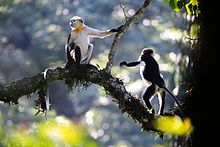Primate sociality
The intersection of these three structures describe the socially complex behaviours and relationships occurring among adult males and females of a particular species.
[1][2][3] Cohesion and stability of groups are maintained through a confluence of factors, including: kinship, willingness to cooperate, frequency of agonistic behaviour, or varying intensities of dominance structures.
The evolution of diverse primate social systems is considered to be a naturally selected anti-predation response.
[7] In fact, many solitary primates maintain social networks by using vocal or olfactory signals to communicate.
[4] If there are other associated females within the group, they will likely have their reproductivity suppressed either via agonistic behaviours (aggressive and submissive interactions)[2] or olfactory signals (such as pheromones).
[4] While tenure ship is held, this form of social organisation allows a male exclusive access to reproductive females for breeding purposes.
This behaviour is interpreted as a strategic attempt to bring females back into estrous, which allows mating opportunities to occur sooner for the new resident male.
Multi-male-multi-female social systems are characterised by associations between larger numbers of individuals forming groups.
[4] Since individuals are able to mate with multiple partners, paternity is often hidden or skewed which helps ensure the survival of off-spring.
[8] For instance, one study of savannah baboons (Papio cynocephalusI) observed that the lactating females in the group would more closely associate with specific adult males.
Interestingly, some researchers hypothesise that fission fusion societies may have been socially inherited from the last shared common ancestor of humans, chimpanzees and bonobos.
[11] Examples of primate species with fission fusion societies: humans,[12] chimpanzees, bonobos, spider monkeys
[14] In order to fully understand how these complex societies function, it is important to observe social relationships and their interactions not only within tiers, but between them as well.
Researchers hypothesize that environmental and social pressures have allowed for a whole array of inter-individual (between individuals) relationships that promote inclusive group fitness.
[1] Inter-individual relationships are thought to be influenced by sex-related variables and can occur (1) between females, (2) between males or (3) between members of the opposite sex.
Factors influencing inter-female relationships are primarily thought to be: food competition; group size; and dispersal patterns.
[1] Socioecological theory predicts that fierce competition exists among male group members over access to females, leading to higher frequencies of agonistic interactions being common.
[1] Finally, intersexual relationships (between adult male and adult female individuals) are also shaped by a number of factors, including sexual selection, dispersal patterns, dominance structures, certainty of paternity, risk of infanticide and/or the level of sexual dimorphism that is present within a species.
[1] Affinity and affiliation between individuals is often largely determined by the dispersal patterns characterizing a primate social system.
Close proximity, grooming and non-aggressive social interactions are expected characteristics of well-bonded primates.
Grooming allows the opportunity for unwanted dirt, dead skin, debris or ectoparasites to be removed from an individual's hair or fur.
A confluence of variables and behaviours, such as diet or dispersal patterns, are thought to shape social systems.
Another pattern reflects a scramble competition, wherein adult males roam the landscape in search of sexually receptive females, moving on shortly after mating.
[1] Finally, groups of males might form coalitions in order to successfully defend mating access to females.








